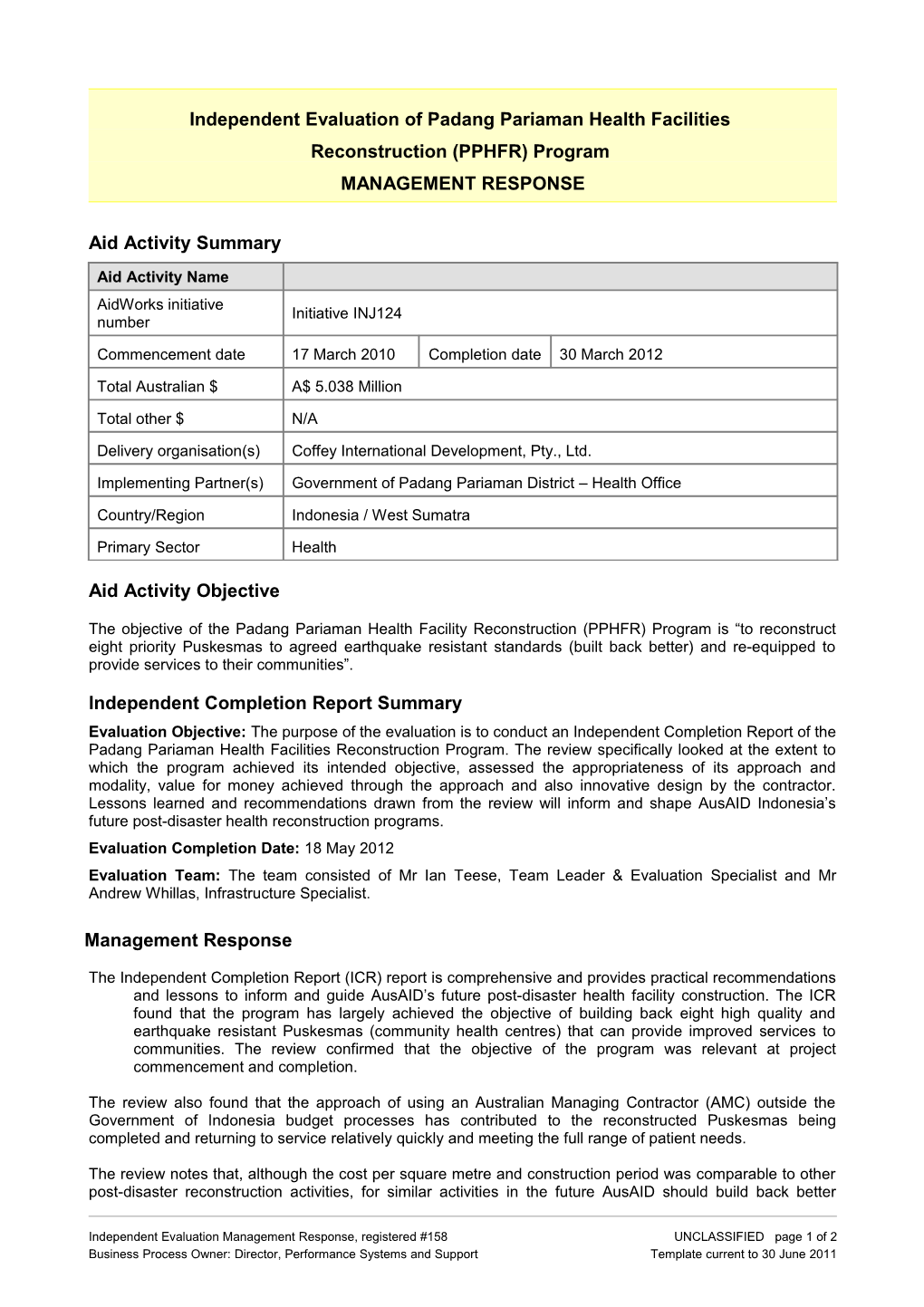Independent Evaluation ofPadang Pariaman Health Facilities
Reconstruction (PPHFR) Program
MANAGEMENT RESPONSE
Aid Activity Summary
Aid Activity NameAidWorks initiative number / Initiative INJ124
Commencement date / 17 March 2010 / Completion date / 30 March 2012
Total Australian $ / A$ 5.038 Million
Total other $ / N/A
Delivery organisation(s) / Coffey International Development, Pty., Ltd.
Implementing Partner(s) / Government of Padang Pariaman District – Health Office
Country/Region / Indonesia / West Sumatra
Primary Sector / Health
Aid Activity Objective
The objective of the Padang Pariaman Health Facility Reconstruction (PPHFR) Program is “to reconstruct eight priority Puskesmas to agreed earthquake resistant standards (built back better) and re-equipped to provide services to their communities”.
Independent Completion ReportSummary
Evaluation Objective:The purpose of the evaluation is to conduct an Independent Completion Report of the Padang Pariaman Health Facilities Reconstruction Program. The review specifically looked at the extent to which the program achieved its intended objective, assessed the appropriateness of its approach and modality, value for money achieved through the approach and also innovative design by the contractor. Lessons learned and recommendations drawn from the review will inform and shape AusAID Indonesia’s future post-disaster health reconstruction programs.
Evaluation Completion Date:18 May 2012
Evaluation Team:The team consisted of Mr Ian Teese, Team Leader & Evaluation Specialist and Mr Andrew Whillas, Infrastructure Specialist.
Management Response
The Independent Completion Report (ICR) report is comprehensive and provides practical recommendations and lessons to inform and guide AusAID’s future post-disaster health facility construction. The ICR found that the program has largely achieved the objective of building back eight high quality and earthquake resistant Puskesmas (community health centres) that can provide improved services to communities. The review confirmed that the objective of the program was relevant at project commencement and completion.
The review also found that the approach of using an Australian Managing Contractor (AMC) outside the Government of Indonesia budget processes has contributed to the reconstructed Puskesmas being completed and returning to service relatively quickly and meeting the full range of patient needs.
The review notes that, although the cost per square metre and construction period was comparable to other post-disaster reconstruction activities, for similar activities in the future AusAID should build back better based on standard GoI designs rather than new building designs. This will help ensure cost and time period for reconstruction remain reasonable and manageable.
The review recommends some additional rectification work be completed by the AMC before retention monies are refunded and strengthening the process of health facility reconstruction process by Government of Indonesia in partnership with Australia in a post disaster response.
AusAID agrees with recommendations 1, 2, 3, 4, 6, and 7 and partially agrees with recommendation 5. Recommendation 5 states that AusAID through Coffey should arrange a 1-2 day workshop for the management of participating Puskesmas, the district health office and the training providers to collate feedback on the program and the Puskesmas design as they relate to future disaster reconstruction activities. Training refresher session on DRR and maintenance issues would be useful additional activities at the workshop. On-site specific training of staff on maintenance and operation of the water-supply system and emergency generator could also be provided.
AusAID partially agrees to this recommendation. Coffey will organise wrap up workshops in all Puskesmas. These wrap up workshops will consist of refresher training in water supply and waste water facilities (as outlined in Recommendation 3), as well as training on maintenance issues and the operationalization of emergency generators which also have been provided to all Puskesmas. However, the wrap up workshops will not include the collection of lessons learnt, as this information will be collected in the review of AusAID disaster responses outlined under Recommendation 6.
AusAID also agrees to all the quality ratings in Table 7 (page 22) except for ‘Monitoring and Evaluation’. The ICR team gave Monitoring and Evaluation a quality rating of ‘4’, or satisfactory. However, AusAID assesses that a rating of ‘3’, or less than satisfactory, is more accurate. As the ICR notes, a comprehensive M&E framework was not developed while monitoring and reporting activities focussed on outputs rather than outcomes. The Scope of Services also did not specify that evaluation information should be collected.
The absence of an M&E framework is understandable. The program was new and novel for both AusAID and the managing contractor and both parties were on a steep learning curb. In all future post-disaster reconstruction programs, AusAID and the managing contractor should work together to ensure comprehensive monitoring and evaluation systems are put in place. The issue of appropriate monitoring and evaluation for post-disaster reconstruction should also be consideredin the review and reconstruction toolkit highlighted in Recommendations Five and Six above.
Independent Evaluation Management Response, registered #158UNCLASSIFIED page 1 of 2
Business Process Owner: Director, Performance Systems and SupportTemplate current to30 June 2011
